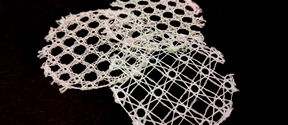Astronomers image a black hole’s shadow and powerful jet together for the first time
Millimeter-VLBI image of the jet and the black hole shadow in Messier 87, obtained with the GMVA array including ALMA, the Greenland Telescope and the telescope at Metsähovi.
An international team of scientists, including Aalto University researchers, has used new millimetre-wavelength observations to produce an image that shows, for the first time, both the ring-like structure that reveals the matter falling into the central black hole and the powerful relativistic jet in the prominent radio galaxy Messier 87. The image underlines for the first time the connection between the accretion flow near the central supermassive black hole and the origin of the jet. The new observations were obtained with the Global Millimetre VLBI Array (GMVA), complemented by the phased Atacama Large Millimetre/submillimetre Array (ALMA) and the Greenland Telescope (GLT). The addition of these two observatories has greatly enhanced the imaging capabilities of the GMVA. The results are published in the current issue of Nature.
‘Previously, we had seen both the black hole and the jet in separate images, but now we have taken a panoramic picture of the black hole together with its jet at a new wavelength,’ says Ru-Sen Lu of the Shanghai Astronomical Observatory, who also leads a Max Planck Research Group at the Chinese Academy of Sciences.
The surrounding material is thought to fall into the black hole in a process known as accretion, but no one has ever imaged it directly. ‘The ring that we have seen before is becoming larger and thicker at 3.5 mm observing wavelength. This shows that the material falling into the black hole produces additional emission that is now observed in the new image. This gives us a more complete view of the physical processes acting near the black hole,’ he added.
The participation of ALMA and GLT in the GMVA observations and the resulting increase in resolution and sensitivity of this intercontinental network of telescopes has made it possible to image the ring-like structure in M87 for the first time at a wavelength of 3.5 mm. The diameter of the ring measured by the GMVA is 64 microarcseconds, which corresponds to the size of a small (5-inch/13-cm) selfie ring light as seen by an astronaut on the Moon looking back at Earth. This diameter is 50 percent larger than what was seen in observations by the Event Horizon Telescope at 1.3 mm, in accordance with the expectations for the emission from relativistic plasma in this region.
‘With the greatly improved imaging capabilities by adding ALMA and GLT into GMVA observations, we have gained a new perspective. We do indeed see the triple-ridged jet that we knew about from earlier VLBI observations,’ says Thomas Krichbaum from the Max Planck Institute for Radio Astronomy (MPIfR) in Bonn. ‘But now we can see how the jet emerges from the emission ring around the central supermassive black hole and we can measure the ring diameter also at another (longer) wavelength.’
The 14-metre radio telescope of the Aalto University Metsähovi Radio Observatory was one of the stations that collected data for the new image.
Tuomas Savolainen, a senior scientist at Aalto University and a co-author of the paper, says that the Metsähovi Radio Observatory has participated in the GMVA measurement campaigns for well over a decade and in VLBI observations at 3.5 mm in general since the mid-1990s.
‘Our radio telescope at Metsähovi was one of only five stations in Europe that participated in these observations in 2018. There are not so many antennas capable of doing measurements at 3.5 mm wavelength, which makes the data gathered at Metsähovi valuable,’ he says.
‘The Event Horizon Telescope image shows the black hole shadow in M87, but those observations were not able to detect the weaker and more extended jet because of the small number of telescopes that participated in them. There are even fewer telescopes capable of observing at 1.3 mm wavelength than there are telescopes observing at 3.5 mm,’ Savolainen says.
The light from M87 is produced by the interplay between highly energetic electrons and magnetic fields, a phenomenon called synchrotron radiation. The new observations, at a wavelength of 3.5 mm, reveal more details about the location and energy of these electrons.
They also tell us something about the nature of the black hole itself: it is not very hungry. It consumes matter at a low rate, converting only a small fraction of it into radiation. Keiichi Asada of the Academia Sinica Institute of Astronomy and Astrophysics explains: ‘To understand the physical origin of the bigger and thicker ring, we had to use computer simulations to test different scenarios. As a result, we concluded that the larger extent of the ring is associated with the accretion flow.’
Kazuhiro Hada from the National Astronomical Observatory of Japan adds: ‘We also find something surprising in our data: the radiation from the inner region close to the black hole is broader than we expected. This could mean that there is more than just gas falling in. There could also be a wind blowing out, causing turbulence and chaos around the black hole.’
The quest to learn more about Messier 87 is not over, as further observations and a fleet of powerful telescopes continue to unlock its secrets. ‘Future observations at millimetre wavelengths will study the time evolution of the M87 black hole and provide a poly-chromatic view of the black hole with multiple colour images in radio light,’ says Jongho Park of the Korea Astronomy and Space Science Institute.
Some of these new observations are taking place this spring, and the Metsähovi Radio Observatory is again taking part in them.
‘3.5 mm is the shortest wavelength at which we operate at the moment, and those observations require good, dry weather conditions. Luckily, the weather in April is often good here. In a couple of years, we will get a new receiver for our telescope that will allow making observations simultaneously over a wide range of wavelengths. Then we will be able to better correct for the distortions in data caused by the atmosphere and obtain even higher quality images,’ says Petri Kirves, Metsähovi Radio Observatory Operations Engineer.
Original publication
R.-S. Lu et al., A ring-like accretion structure in M87 connecting its black hole and jet, Nature, April 27, 2023: https://doi.org/10.1038/s41586-023-05843-w
Contact information
Tuomas Savolainen
Senior Scientist
Aalto University Metsähovi Radio Observatory, Department of Electronics and Nanoengineering
tuomas.k.savolainen@aalto.fi
Mobile: +358 50 308 3696
Dr. Ru-Sen Lu
Shanghai Astronomical Observatory
Chinese Academy of Sciences, Shanghai
Fon: +86-21-34776078
Mail: rslu@shao.ac.cn
Dr. Keiichi Asada
Institute of Astronomy and Astrophysics, Academia Sinica, Taipei
Fon: +886-2-2366-5410
Mail: asada@asiaa.sinica.edu.tw
Dr. Thomas P. Krichbaum
Max-Planck-Institut für Radioastronomie
Bonn, Germany
Fon: +49 228 525 292
Mail: tkrichbaum@mpifr.de
Dr. Kazuhiro Hada
National Astronomical Observatory of Japan
Phone: +81-197-22-7129
Mail: kazuhiro.hada@nao.ac.jp
This research has made use of data obtained with the Global Millimeter VLBI Array (GMVA), which consists of telescopes operated by the Max-Planck-Institut für Radioastronomie (MPIfR), Institut de Radioastronomie Millimétrique (IRAM), Onsala Space Observatory (OSO), Metsähovi Radio Observatory (MRO), Yebes, the Korean VLBI Network (KVN), the Green Bank Telescope (GBT) and the Very Long Baseline Array (VLBA).
ALMA construction and operations are led by ESO on behalf of its Member States; by the National Radio Astronomy Observatory (NRAO), managed by Associated Universities, Inc. (AUI), on behalf of North America; and by the National Astronomical Observatory of Japan (NAOJ) on behalf of East Asia. The Joint ALMA Observatory (JAO) provides the unified leadership and management of the construction, commissioning and operation of ALMA.
The Greenland Telescope (GLT) retrofit, rebuild, and operation are led by the Academia Sinica, Institute of Astronomy and Astrophysics (ASIAA) and the Smithsonian Astrophysical Observatory (SAO).
The Green Bank Observatory (GBT) and the National Radio Astronomy Observatory (VLBA) are major facilities of the National Science Foundation, operated under cooperative agreement by Associated Universities, Inc.
The data were correlated at the Max Planck Institute for Radio Astronomy (MPIfR), which also operates the Global Millimeter-VLBI Array (GMVA).
The research team comprises Ru-Sen Lu, Keiichi Asada, Thomas P. Krichbaum, Jongho Park, Fumie Tazaki, Hung-Yi Pu, Masanori Nakamura, Andrei P. Lobanov, Kazuhiro Hada, Kazunori Akiyama, Jae-Young Kim, Iván Martí-Vidal, José L. Gómez, Tomohisa Kawashima, Feng Yuan, Eduardo Ros, Walter Alef, Silke Britzen, Michael Bremer, Avery Broderick, Akihiro Doi, Gabriele Giovannini, Marcello Giroletti, Paul Ho, Mareki Honma, David Hughes, Makoto Inoue, Wu Jiang, Motoki Kino, Shoko Koyama, Michael Lindqvist, Jun Liu, Alan Marscher, Satoki Matsushita, Hiroshi Nagai, Helge Rottmann, Tuomas Savolainen, Karl-Friedrich Schuster, Zhi-Qiang Shen, Pablo de Vicente, R. Craig Walker, Hai Yang, J. Anton Zensus, Juan Carlos Algaba, Alexander Allardi, Uwe Bach, Ryan Berthold, Dan Bintley, Do-Young Byun, Carolina Casadio, Shu-Hao Chang, Chih-Cheng Chang, Song-Chu Chang, Chung-Chen Chen, Ming-Tang Chen, Ryan Chilson, Tim Chuter, John Conway, Geoffrey Crew, Jessica Dempsey, Sven Dornbusch, Aaron Faber, Per Friberg, Javier González-García, Miguel Gómez-Garrido, Chih-Chiang Han, Kuo-Chang Han, Yutaka Hasegawa, Ruben Herrero-Illana, Yau-De Huang, Chih-Wei Huang, Violette C.M. Impellizzeri, Homin Jiang, Hao Jinchi, Taehyun Jung, Juha Kallunki, Petri Kirves, Kimihiro Kimura, Jun Yi Koay, Patrick Koch, Carsten Kramer, Alexander Kraus, Derek Kubo, Cheng-Yu Kuo, Chao-Te Li, Chun-Che Lin, Ching-Tang Liu, Kuan-Yu Liu, Wen-Ping Lo, Li-Ming Lu, Nicholas R. MacDonald, Pierre Martin-Cocher, Hugo Messias, Zheng Meyer-Zhao, Anthony Minter, Dhanya Nair, Hiroaki Nishioka, Timothy Norton, George Nystrom, Hideo Ogawa, Peter Oshiro, Nimesh Patel, Ue-Li Pen, Yurii Pidopryhora, Nicolas Pradel, Philippe Raffin, Ramprasad Rao, Ignacio Ruiz, Salvador Sánchez, Paul Shaw, William Snow, T. K. Sridharan, Ranjani Srinivasan, Belén Tercero, Pablo Torne, Efthalia Traianou, Jan Wagner, Craig Walther, Ta-Shun Wei, Jun Yang, and Chen-Yu Yu.
The research team includes following researchers affiliated to Aalto University: Juha Kallunki, Petri Kirves, and Tuomas Savolainen.
Metsähovi Radio Observatory helps reveal the secrets of black holes
Together with other observatories around the world, Aalto University’s Metsähovi Radio Observatory has captured an unprecedented image of a black hole.

Read more news

Learning Centre opening hours during Christmas and year-end holidays
Thank you for the past year and have a wonderful holiday season!
Smart textiles are reshaping our understanding of materials – and interspecies communication
The PAST-A-BOT research project, funded by the European Research Council (ERC), is developing soft, intelligent textiles that could one day function as rescue robots, sound-sensing agricultural fabrics, or assistive clothing. At the same time, the project aims to rethink the way we approach materials research.
Master’s student showcases efficient color stripping of cotton fabrics
On December 9, master’s thesis student Elsa Vuorenmaa from the Textile Chemistry Group presented the results of her research on color stripping of reactive-dyed cotton fabrics.









